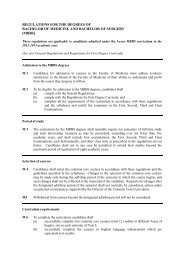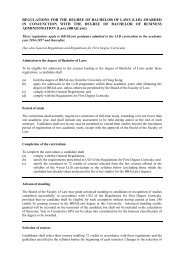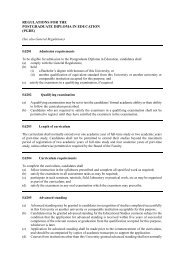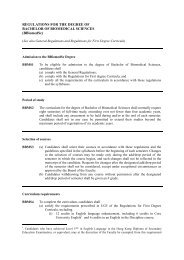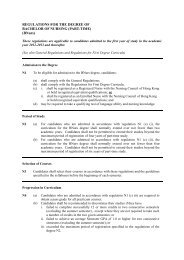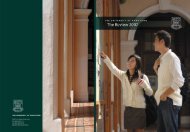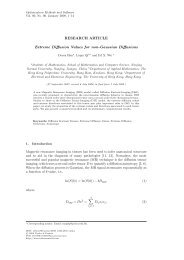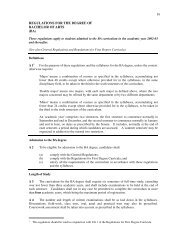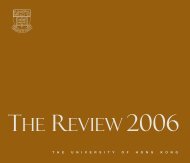Bachelor of Arts (BA) - The University of Hong Kong
Bachelor of Arts (BA) - The University of Hong Kong
Bachelor of Arts (BA) - The University of Hong Kong
You also want an ePaper? Increase the reach of your titles
YUMPU automatically turns print PDFs into web optimized ePapers that Google loves.
179GEOG2015.Environmental monitoring and assessment (6 credits)(This course is also <strong>of</strong>fered to second and third year non-<strong>BA</strong> students for inter-Faculty broadeningpurposes.)<strong>The</strong> course is divided into two parts. <strong>The</strong> first part deals with basic environmental monitoringmethodology and techniques, which are how to obtain and analyse information on the existence andconcentration <strong>of</strong> substances in the environment, either naturally occurring or from anthropogenicsources. <strong>The</strong> second part provides a basic concept and nature <strong>of</strong> environmental assessment (EA or EIA),an exploration <strong>of</strong> best practice in EA and a description <strong>of</strong> EA procedures.Assessment: 40% coursework, 60% examination.This course will be <strong>of</strong>fered in the first semester.GEOG2018.Transport geography (6 credits)(This course is also <strong>of</strong>fered to second and third year non-<strong>BA</strong> students for inter-Faculty broadeningpurposes.)This course provides an understanding <strong>of</strong> the spatial structures and development <strong>of</strong> transport systemsfrom a people-oriented geographical approach. This approach emphasizes the role <strong>of</strong> people indetermining the evolution and use <strong>of</strong> transport systems and the role <strong>of</strong> the transportation systems inserving and changing our daily life through improving accessibility and mobility. <strong>The</strong> course will coverthe fundamentals <strong>of</strong> geographical analysis on transport, the analysis on transport demand, supply andregulations, and the relationship between transport and development. Case studies <strong>of</strong> airports, ports,and urban transport networks provide explanations about the mechanisms and dynamics <strong>of</strong> transportsystems in different geographical situations, and how they interact with local and global development.Assessment: 40% coursework, 60% examination.This course will be <strong>of</strong>fered in the second semester.GEOG2019.Environmental GIS * (6 credits)(This course is also <strong>of</strong>fered to second and third year non-<strong>BA</strong> students for inter-Faculty broadeningpurposes.)This course introduces students to the methods <strong>of</strong> overlaying and merging <strong>of</strong> spatial data layers inenvironmental monitoring and decision making. <strong>The</strong> principles <strong>of</strong> such an approach will be discussedfocusing on the nature <strong>of</strong> environmental data (particularly the raster data structure and remote sensingimages), data transformation and geocoding, modeling techniques, and accuracy evaluation <strong>of</strong> spatialdatabases. Students must complete a simple project embodying the application <strong>of</strong> the GIS concept in anenvironmental situation.Assessment: 40% coursework, 60% examination.This course will be <strong>of</strong>fered in the second semester.* = Course to be <strong>of</strong>fered in biennial even year, i.e. in 2002-03, 2004-05 and so on.



